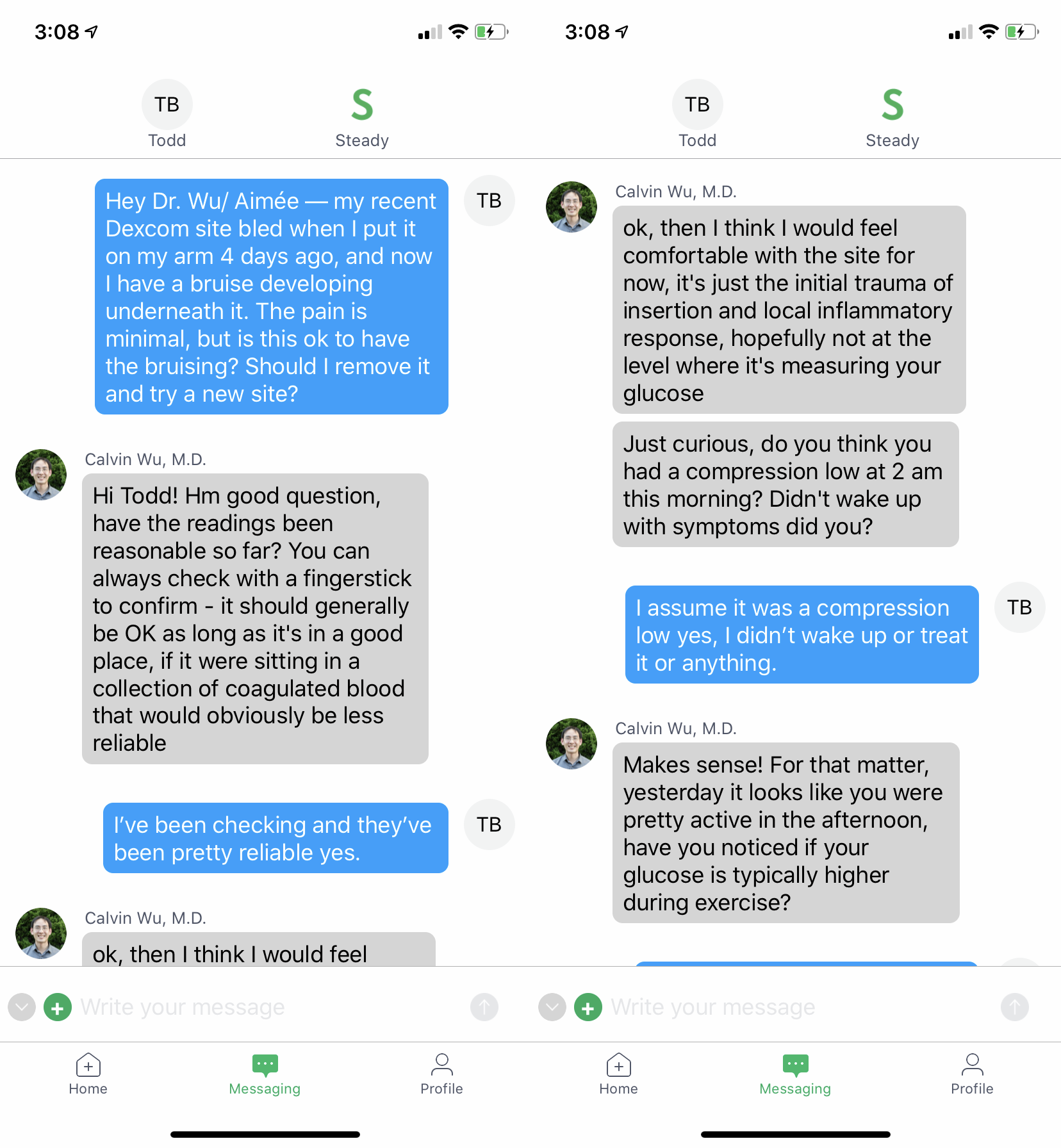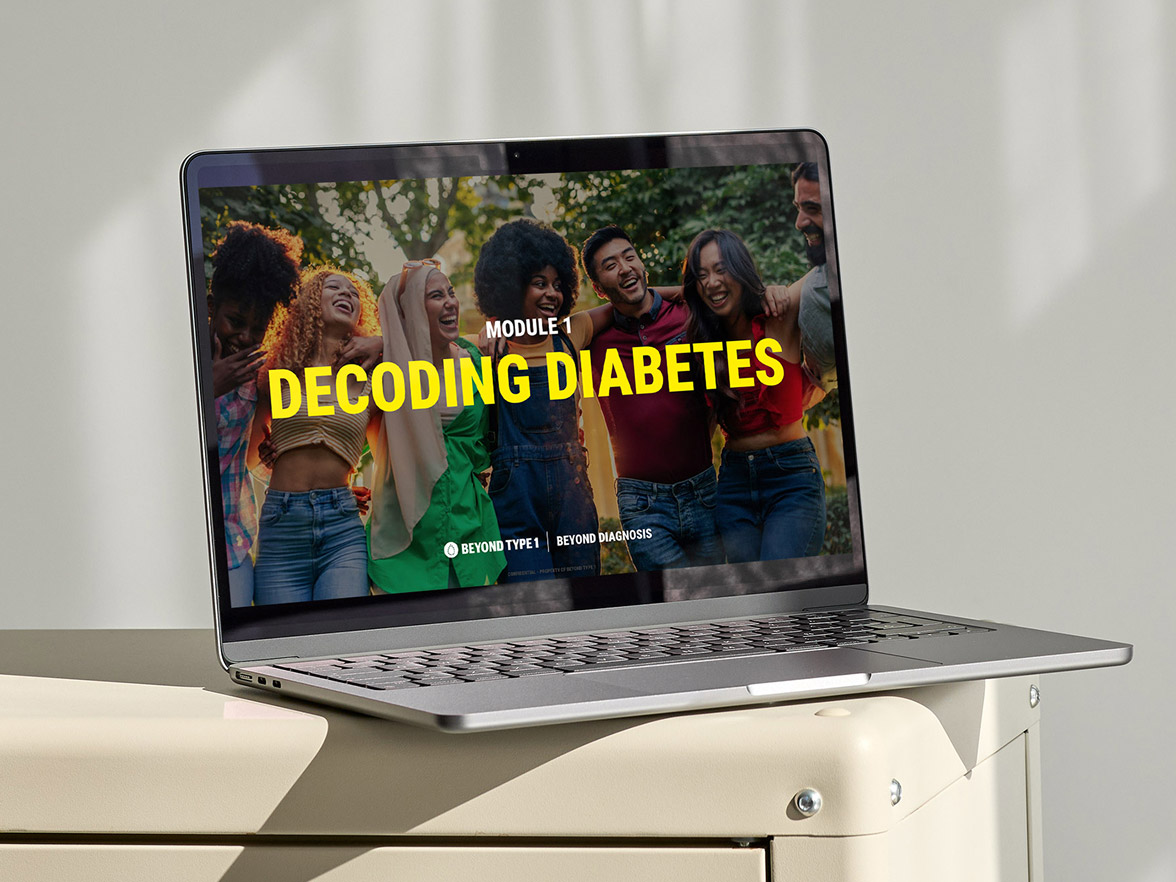Steady Health: A New Type of Diabetes Care
Written by: Todd Boudreaux
6 minute read
October 17, 2019
Typical diabetes care
For many of us living with diabetes, there was only one time in our lives when we had extensive training and coaching on the best ways to manage our disease—and that was at diagnosis. This was certainly the case for me. In 2000, at age 13, I spent a long weekend in Oakland Children’s Hospital learning what diabetes was, how to check my blood sugar and how to inject oranges with insulin. That four-day weekend was the longest amount of time I ever spent discussing my diabetes with healthcare professionals. I was “lucky” in that I was old enough to be in charge of my own diabetes care and old enough to remember the training.
Every appointment with an endocrinologist since diagnosis has followed a similar pattern that will seem familiar to many:
- Look at your recent blood sugars and A1C.
- Go over your insulin doses and carb ratios.
- Suggest different insulin doses and/or carb ratios to obtain better results.
- Ask if you need prescription refills.
- Schedule a follow up appointment in three to six months
I have gone through this very predictable pattern perhaps 40-50 times. Prior to Steady Health, the longest period of time I had spent talking to an endocrinologist about my diabetes post-diagnosis was probably 15 minutes. I understand why things are done this way. I know that doctor’s schedules fill up quickly and they can only spare so much time in a day for their many, many patients. And for the most part, this system worked for me. Diabetes is unpredictable, and having a general knowledge and checking in with a professional at a regular cadence is a very good way to manage a chronic condition. Seeing an endocrinologist multiple times a year on its own is a luxury that many living with diabetes don’t have access to.
The experiment
Steady Health’s aim is to shift the paradigm and change the way diabetes is managed. Their offer is enticing: a diabetes care team that is responsive to your questions throughout the week, while monitoring your progress remotely. Additionally the endocrinology appointments are long (30-90 minutes), offering a deep dive into your current and future management.
I first read Henrik Berggren’s story about a continuous glucose monitor (CGM) changing his life months ago, and it conjured up a few thoughts for me.
- CGM technology had changed my life dramatically
- I was only really scratching the surface of what this technology is capable of
- I am unlikely to spend the time meticulously documenting and analyzing my food and activity the way Henrik had to “hack” his diabetes
As they geared up for launch, Steady Health offered their service for free for six months to us “Beta” testers, so with that in mind, I signed up to see what I could gain from a deeper dive into my diabetes management with help from professionals.
Signing up
The signup process was relatively easy. I was directed to download an app from the website. I filled out some basic information and then I got my first message welcoming me to the service and directing me to an online questionnaire. With that I set up my first intake appointment. I connected my CGM data to the service and was on my way.
The Steady Health app was easy to download, and fairly intuitive. There are three main functions of the app which will be reviewed in greater depth.
- Communicating with the care team
- Making Appointments, logistics
- Logging food and activity during the two week logging period
The intake appointment
My initial appointment at Steady Health was eye-opening in a few different ways. For one, I had never met with a certified diabetes educator (CDE) before. The concept of having not just an endocrinologist but an entire diabetes care team was novel to me, although I’m aware that others have had care teams for years.
I met my endocrinologist, Calvin Wu and CDE, Aimee Jose and discussed my diabetes in detail. It was similar to an intake appointment at any new endocrinologist, but significantly longer. Questions that are typically relegated to forms about topics like exercise, eating habits and diabetes management were explored in greater depth.
There is one aspect that might weird out those less comfortable discussing their health issues. Someone outside of the office (in this case Nilou—the Steady Health Member Guide) listens in to the entire appointment taking notes. I am an open book when it comes to my health, but for those wary of speaking with doctors openly and honestly, having yet another unseen person listen in to the conversation might be a little unnerving.
My initial appointment was 90 minutes, and as mentioned before, it was the most time I had spent discussing my diabetes and treatment options with a healthcare professional since I was diagnosed in 2000. The real selling point of Steady Health is their ability to help you interpret your CGM data and advise on management options after a tracking period during which time you log everything you eat and drink.
The tracking period

One of the aspects of the Steady Health experience I was looking forward to the most was the professional interpretation of CGM data, because what is data without background insights?
During the two-week tracking period, you log everything you eat and drink into the app. The folks at Steady Health know that carbohydrate counts aren’t always reliable, and so you log your meals by taking pictures of them and uploading them into the app. I asked prior to my intake appointment about whether or not I should log food without carbs and the answer was a definitive YES. This would prove particularly instrumental later in finding out what effect caffeine had on my blood glucose levels.
Although the idea is to do a tracking period at the beginning to analyze your data, you can do tracking periods at any time while under the care of Steady Health to evaluate how your current management is working.
Taking pictures of food had a secondary effect on me. There’s something about taking a picture of your food that really brings your eating habits to light. Walking back and forth to the kitchen every 10 minutes to grab just a few more peanut-butter filled pretzels doesn’t seem like a big deal until you end up with five pictures on your phone of four to five of them, and you realize you’ve had 25 in the last hour. After the tracking period I went in for my second appointment, which was possibly the most useful and insightful diabetes discussion I have ever had in my life.
The followup appointment
I consider myself to be pretty knowledgeable about diabetes, and I feel like I’m pretty in-tune with myself, so honestly, I wasn’t expecting much heading into the ‘deep dive’ appointment during which we reviewed my data. But I did get some major insights:
- Around 6 a.m., my blood sugar would go up. Every morning this was the case. So I upped my basal rate starting at 5 a.m. and now I am no longer experiencing that spike.
- Caffeine has a major effect on me. I was a little dubious about taking pictures of everything, but sure enough, even carb-free coffee had a serious effect on my blood sugar I was unaware of. I now take insulin with my coffee.
- My time-in-range was not at all what I expected or where I wanted it to be.
At this followup appointment you also set some personal goals: Mine were to get an HbA1c < 7%, improve my time in range to 70-80%, develop more confidence in not over-treating lows, and to lose 10lbs of weight.
Endocrinologist accessibility
One of the best things about Steady Health is the constant contact via in-app messaging with my diabetes care team. To have an endocrinologist and CDE available to answer your questions within minutes is a luxury that really can’t be overstated. At one point, something happened to me that had never happened before. There was significant bruising around my Dexcom site and it appeared to be getting worse. I didn’t want to take off my CGM unnecessarily, so I reached out to my care team for advice on the situation, and Dr. Wu got back to me almost immediately:

In addition to being responsive to my questions, the Steady Health team checked in frequently and proactively with advice and metrics on how my management was going. The team is also flexible about being as involved as you want them to be. For example, I was having a hard time with weekly check-ins, so Dr. Wu suggested we could switch to monthly check-ins.
Another great feature of Steady Health is their virtual appointments. Just last week I had a 30-minute video call with Aimee and Dr. Wu to discuss progress on my goals, how treatment was going, and if there were any new concerns, questions, or specific areas of my diabetes management we could tackle together.
Overall impressions
My experience with Steady Health has been wholly positive. The quick access to a diabetes care team, the insights gained from having someone else track my data for two weeks, and the ease of use and app were all huge advantages over the way I’ve managed my diabetes in the past.
One potential downside I could see is the price—a $59/month membership fee (which was waived for me during the trial period)—might not be worth it for some. In addition to the monthly fee, endocrinology appointments are priced and covered by insurance the same way your current endocrinology appointments are.
Like everything in life, but especially the treatment of a chronic condition, you will get out of Steady Health what you put into it. Diabetes management is already a lot of work! There is no getting around the fact that taking full advantage of this service requires even more work. That said, they certainly make it easer for you by providing insights and being proactive through the app.
Another limiting aspect is location. Steady Health currently has one office in San Francisco, but they have patients all over California, with plans to expand to more states in the future.
There is no perfect way to manage diabetes and one size does not fit all. But Steady Health did the best job of any diabetes care I’ve received to date by tailoring their service to me and providing valuable insights with a relatively low lift required on my end.

Author
Todd Boudreaux
<a href="https://beyondtype1.org//leadership/todd-boudreaux/">Todd</a> was diagnosed with type 1 diabetes in 2000, and has been unofficially advocating for type 1 diabetes (T1D) ever since. Before joining the team at Beyond Type 1, Todd wrote and produced television shows for Discovery Channel, Travel Channel and Animal Planet. When he’s not in the office, you can usually find him at a baseball game, traveling, or drawing on his Etch A Sketch. You can also <a href="https://www.instagram.com/toddboo/">follow him on Instagram.</a>
Related Resources

Hyperglycemia—or high blood sugar—can sneak up on you, whether it’s from a missed dose, a...
Read more

Curious about how to join a diabetes clinical trial? If so, good on ya’, because...
Read more

Diabetes clinical trials pave the way for how we manage and treat type 1 and...
Read more

